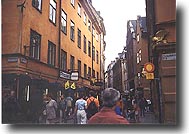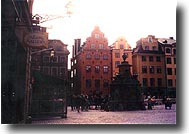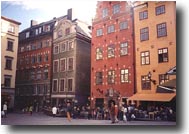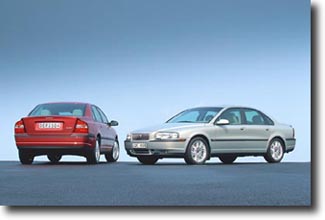 |
RIDING LARGE INTO THE NEXT CENTURY |
by Marc J. Rauch, Executive Vice President & Co-Publisher
(Editor's Note - Marc's story about the S80 and his visit to Sweden includes several streaming video clips. The video clips include interviews, news releases, and the official S80 press introduction. Viewing these clips will help you to enjoy and understand the overall story. To view the clips you will need the Windows Media Player plugin, which can be downloaded free of charge by clicking on the icon below. Please follow the complete installation instructions.)
Meeting Welcome: Bob Austin, Director of Marketing Communications, Volvo Cars of North America 28.8 or 56k
S80 Introduction: Hans Wikman, Project Director, Volvo S80 28.8 or 56k
Interview: Curt Germundsson, Senior Vice President, Car Manufacturing 28.8 or 56k
S80 Factory Footage 28.8 or 56k
Passive Safety Presentation 28.8 or 56k
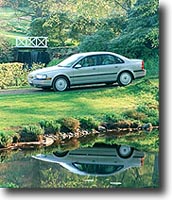 In horse racing terms, it looks like Volvo is on the verge of winning the Triple Crown. There was Volvo's European introduction of the S40 and V40 (both coming to America next year), the introduction of the C70 Convertible (which I detailed in an earlier review), and now, Volvo's large platform thoroughbred, the S80. While the S40 and V40 have had great success in Europe, and virtually all auto journalists rave about the Convertible, I predict that Volvo's first foray into the luxury car market will be their biggest victory.
In horse racing terms, it looks like Volvo is on the verge of winning the Triple Crown. There was Volvo's European introduction of the S40 and V40 (both coming to America next year), the introduction of the C70 Convertible (which I detailed in an earlier review), and now, Volvo's large platform thoroughbred, the S80. While the S40 and V40 have had great success in Europe, and virtually all auto journalists rave about the Convertible, I predict that Volvo's first foray into the luxury car market will be their biggest victory.
The S80 is intended to accomplish two goals: provide current Volvo owners with something that they can step-up to, and to offer all potential owners of a "European" luxury car a different option. Previously, Volvo owners could only advance so high up the prestige ladder, and then had to move to another manufacturer's product (all the customer loyalty in the world won't stop a man or woman from claiming the just rewards of their hard work). Although Volvo acknowledges that it will be very difficult to attract those individuals who are steely determined to own a Mercedes or BMW, they have high hopes for Volvo-brand devotees and those folks with "softer" resolve.
In late July, I made my first trip to Gothenburg, Sweden, the home of Volvo. It gave me the chance to test the S80, speak first hand with the people responsible for creating the vehicle, and to renew my acquaintance with Jose Diaz de la Vega, Chief Designer for Interior, and Colour & Trim at Volvo Car Corporation. As an added bonus, by the end of a week, I think I discovered why Volvo makes such safe cars (I'll reveal the secret a little later in this story).
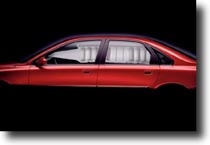 Speaking of safety, Volvo is proclaiming the S80 as the safest Volvo ever. Considering their distinguished reputation, establishing a new benchmark is no mean feat. But packed with active and passive safety features, the achievement, if not just the pronouncement, is impressive. By the way, active refers to those mechanisms or devices that are part of the normal operating characteristics of the vehicle; i.e., braking system, suspension, traction control, and optics (front and rear lights). Passive refers to those mechanisms or devices that are called upon and put into use only when specific passenger protection is required; i.e., the deployment of airbags in an actual collision.
Speaking of safety, Volvo is proclaiming the S80 as the safest Volvo ever. Considering their distinguished reputation, establishing a new benchmark is no mean feat. But packed with active and passive safety features, the achievement, if not just the pronouncement, is impressive. By the way, active refers to those mechanisms or devices that are part of the normal operating characteristics of the vehicle; i.e., braking system, suspension, traction control, and optics (front and rear lights). Passive refers to those mechanisms or devices that are called upon and put into use only when specific passenger protection is required; i.e., the deployment of airbags in an actual collision.
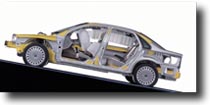 The passive safety system includes two important new features: WHIPS, Whiplash Protection System; and IC, Inflatable Curtain. WHIPS was an R&D project designed to produce a seat which could reduce the incidence and severity of injuries from rear-end collisions. While whiplash injuries have still not been fully explained in medical terms, it is clear that they are caused by sudden violent movement of the head - backwards and then forwards - known as the catapult effect.
The passive safety system includes two important new features: WHIPS, Whiplash Protection System; and IC, Inflatable Curtain. WHIPS was an R&D project designed to produce a seat which could reduce the incidence and severity of injuries from rear-end collisions. While whiplash injuries have still not been fully explained in medical terms, it is clear that they are caused by sudden violent movement of the head - backwards and then forwards - known as the catapult effect.
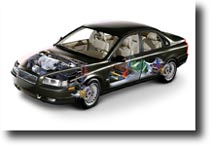 Since rear-end collisions often occur in slower moving city traffic, the Volvo WHIPS system is optimized to be most effective at speeds ranging from 10 mph to 20 mph. The two-stage system is activated the moment the car is hit from behind and based on two mechanical parts. During the first stage, after the impact, the body is thrown backwards and then cushioned in a controlled manner with the whole of the spine safely against the backrest. In order to reduce the g force, the backrest is allowed to move backwards with the occupant. This backward movement prevents the body being thrown forwards. The upper part of the backrest moves upwards and forwards, thereby providing extra support and protection for the neck and head. In the second stage, the WHIPS mechanism allows the backrest to tilt backwards, up to 15 degrees, thereby absorbing impact energy, reducing the movement of the body and heavily reducing the risk of the catapult effect. Tests conducted by Volvo during the development of the system reveal that the WHIPS system can reduce the acceleration forces in the neck by some 50 per cent.
Since rear-end collisions often occur in slower moving city traffic, the Volvo WHIPS system is optimized to be most effective at speeds ranging from 10 mph to 20 mph. The two-stage system is activated the moment the car is hit from behind and based on two mechanical parts. During the first stage, after the impact, the body is thrown backwards and then cushioned in a controlled manner with the whole of the spine safely against the backrest. In order to reduce the g force, the backrest is allowed to move backwards with the occupant. This backward movement prevents the body being thrown forwards. The upper part of the backrest moves upwards and forwards, thereby providing extra support and protection for the neck and head. In the second stage, the WHIPS mechanism allows the backrest to tilt backwards, up to 15 degrees, thereby absorbing impact energy, reducing the movement of the body and heavily reducing the risk of the catapult effect. Tests conducted by Volvo during the development of the system reveal that the WHIPS system can reduce the acceleration forces in the neck by some 50 per cent.
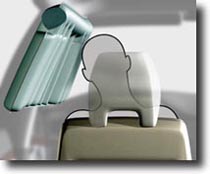 The Inflatable Curtain, was also presented as an R&D project in 1997, the first technical system of its kind. The goal of IC is to reduce injuries from a side impact by protecting the heads of the occupants. The curtains, one on each side, are woven in one piece, and hidden inside the roof lining. They cover the upper part of the interior, from the A pillar to the rear side pillar, thereby protecting the occupants in the front and rear seats. The IC is activated by the same sensors as the SIPS bags (side impact protection system). They are "slave" sensors to a central sensor that determines where the impact is and which bag should be triggered in order to protect the occupants. The Inflatable Curtain is only activated on the side that is hit. If only the rear sensor is affected, the IC is activated but not the SIPS bag.
The Inflatable Curtain, was also presented as an R&D project in 1997, the first technical system of its kind. The goal of IC is to reduce injuries from a side impact by protecting the heads of the occupants. The curtains, one on each side, are woven in one piece, and hidden inside the roof lining. They cover the upper part of the interior, from the A pillar to the rear side pillar, thereby protecting the occupants in the front and rear seats. The IC is activated by the same sensors as the SIPS bags (side impact protection system). They are "slave" sensors to a central sensor that determines where the impact is and which bag should be triggered in order to protect the occupants. The Inflatable Curtain is only activated on the side that is hit. If only the rear sensor is affected, the IC is activated but not the SIPS bag.
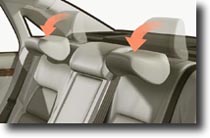 In addition to WHIPS, IC, and SIPS, other safety features include folding rear head restraints, and an integrated child booster cushion, (used with the center rear seatbelt and adjustable head restraint for children aged four and up). The S80's traction control systems, braking systems, and suspension systems all benefit years of experience and excellent track records.
In addition to WHIPS, IC, and SIPS, other safety features include folding rear head restraints, and an integrated child booster cushion, (used with the center rear seatbelt and adjustable head restraint for children aged four and up). The S80's traction control systems, braking systems, and suspension systems all benefit years of experience and excellent track records.
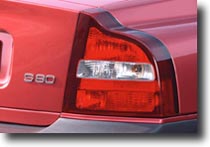 Esthetically, the S80 is wonderfully designed. It is one big beautiful motor car. Like Volvo's C line offerings, the C70 Coupe and Convertible, the S80 does not suffer from any of the traditional Volvo boxiness. But then, why would it: this is the Swedish car maker's look of the future, not the past. Long, graceful lines accent the car's dimensions, and its oversized tail-light/reflectors put just the right finishing touch on an overall bold statement.
Esthetically, the S80 is wonderfully designed. It is one big beautiful motor car. Like Volvo's C line offerings, the C70 Coupe and Convertible, the S80 does not suffer from any of the traditional Volvo boxiness. But then, why would it: this is the Swedish car maker's look of the future, not the past. Long, graceful lines accent the car's dimensions, and its oversized tail-light/reflectors put just the right finishing touch on an overall bold statement.
Naturally, the new large platform requires large, powerful engines. And Volvo has responded to this need with an array of efficient, economy-minded power plants in both the six cylinder and five cylinder varieties. All are transverse mounted.
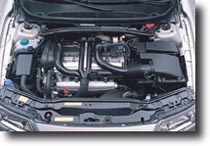 The five cylinder engines provide the best fuel economy and are intended only for the European market, where the price of petrol is ridiculously high. A total of 5 different versions will eventually be offered: 2 liter high-pressure turbo, 2 liter light-pressure turbo, 2.4 liter 170 hp (normally aspirated), 2.4 liter 140 hp (normally aspirated), and a 2.5 liter turbodiesel.
The five cylinder engines provide the best fuel economy and are intended only for the European market, where the price of petrol is ridiculously high. A total of 5 different versions will eventually be offered: 2 liter high-pressure turbo, 2 liter light-pressure turbo, 2.4 liter 170 hp (normally aspirated), 2.4 liter 140 hp (normally aspirated), and a 2.5 liter turbodiesel.
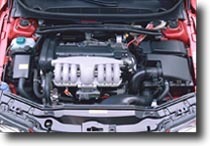 For the North American market, the S80 will be offered with a choice of two different inline six cylinder engines: one is normally aspirated, the other is a high-performance twin turbo, the T6. The 2.9 liter normally aspirated motor delivers 204 horse power, and is a revised version of Volvo's tried-and-true 3 liter six cylinder. The T6 twin-turbo puts out 272 horses, comparable to a V8, and is married to a Geartronic transmission for manual shifting capabilities.
For the North American market, the S80 will be offered with a choice of two different inline six cylinder engines: one is normally aspirated, the other is a high-performance twin turbo, the T6. The 2.9 liter normally aspirated motor delivers 204 horse power, and is a revised version of Volvo's tried-and-true 3 liter six cylinder. The T6 twin-turbo puts out 272 horses, comparable to a V8, and is married to a Geartronic transmission for manual shifting capabilities.
The first day's test drive was to take us from our base hotel in Gothenburg, north to Gustafsberg for lunch. We assembled outside the Hotel 11, which despite its name was not Motel 6 plus five. The "11" is apparently a reference to its origin as a ship building plant (Gothenburg was an important ship building port). My driving companion was syndicated automotive journalist Carey Russ, who also writes for The Auto Channel. There were a couple dozen silver T6 engined cars and an equal number of blue 2.9 liter vehicles from which to choose. We took a blue.


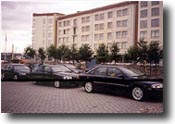
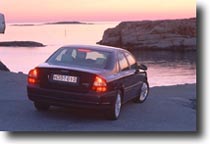 The drive up the coast was leisurely and uneventful. The quality of northern sunlight struck me immediately. It's very different from the luminance of the sun bleached California skies I've become accustomed to. Colors looked different and my depth perception was somewhat altered. In general, Sweden is an interesting place. While it doesn't quite have all the charm of other European countries, it also doesn't appear to have their poverty and civil strife. I guess I'm equating "charm" with old buildings, so don't take this remark as a real negative - there's a lot to be said for clean and modern. In any event, Sweden is about the size of California with only a fraction of the Golden State's population. Consequently, there's plenty of room and lots of open space. Swedes appear to be fluent in English and seem to be happy to speak it. There are McDonald's restaurants everywhere and the big chain of highway rest-stop restaurants is called Route 66. You'll also find the best ice cream you've ever tasted at every turn, but the amazing thing is that Swedes all look so fit and trim.
The drive up the coast was leisurely and uneventful. The quality of northern sunlight struck me immediately. It's very different from the luminance of the sun bleached California skies I've become accustomed to. Colors looked different and my depth perception was somewhat altered. In general, Sweden is an interesting place. While it doesn't quite have all the charm of other European countries, it also doesn't appear to have their poverty and civil strife. I guess I'm equating "charm" with old buildings, so don't take this remark as a real negative - there's a lot to be said for clean and modern. In any event, Sweden is about the size of California with only a fraction of the Golden State's population. Consequently, there's plenty of room and lots of open space. Swedes appear to be fluent in English and seem to be happy to speak it. There are McDonald's restaurants everywhere and the big chain of highway rest-stop restaurants is called Route 66. You'll also find the best ice cream you've ever tasted at every turn, but the amazing thing is that Swedes all look so fit and trim.
Gustafsberg is northern Europe's oldest seaside resort. It is both charming and clean. We were greeted by a terrific "Om Pa" band, which only added to the friendliness of the surroundings. Unfortunately, it was cool and rainy: I would have loved to sit out by the waterfront with a glass of akvavit.

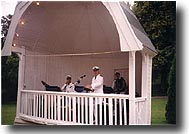
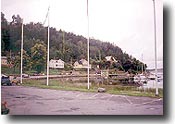
 On the return trip, Carey and I got a little lost - I was driving. However we did find our way to the Bohus Fortress, a 14th century castle that had been occupied by various Danish, Swedish, and Norwegian kings. At Bohus, the same weather that detracted from our visit to Gustafsberg, only heightened this experience. The cool temperatures and rainy condition befit the occasion. Alas, try as we might, we witnessed no ghosts.
On the return trip, Carey and I got a little lost - I was driving. However we did find our way to the Bohus Fortress, a 14th century castle that had been occupied by various Danish, Swedish, and Norwegian kings. At Bohus, the same weather that detracted from our visit to Gustafsberg, only heightened this experience. The cool temperatures and rainy condition befit the occasion. Alas, try as we might, we witnessed no ghosts.
On the second day, Carey and I switched to a silver S80 with the T6 twin-turbo engine. Our destination was the island town of Marstrand, for lunch at the Grand Hotel. Similar to the previous day, the drive was uneventful. However, the T6 did provide a little more excitement. I found using the smooth Geartronic to be a blast as we zipped and zoomed through the countryside. Getting to the island itself you have to park and take a very short ferryboat ride. We disembarked at a very lovely, very "charming", and again, very clean fairytale looking village. Wait a minute, wasn't that me who wrote that there wasn't so much charm to this place!
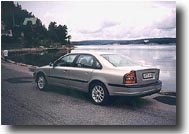
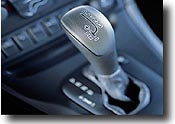
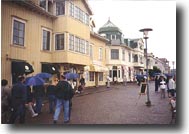
After a delicious lunch and short walk around the island we headed back to Gothenburg. Frankly, we were both anxious to drive the T6 again.
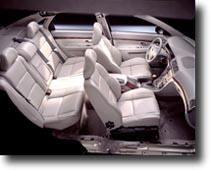 From a pure driving experience standpoint, both versions of the S80 ride and handle as beautifully as they look. They have all the best aspects of what I call "American Plush": powerful and velvety. Yet unlike some big Yank cars, they don't feel "boaty". The ride is luxurious; the seats relaxing; and if you're using the Dolby Pro Logic Surround audio system, you'll think you're in a concert hall. The rear seat is very roomy and is designed to fit three full sized passengers. Yes, the twin-turbo gives you more punch, but the 2.9 liter model is no slouch. It provides ample power, which in my opinion equals a very satisfying performance. I still easily accelerated to highway speed and passed other vehicles as needed with complete confidence.
From a pure driving experience standpoint, both versions of the S80 ride and handle as beautifully as they look. They have all the best aspects of what I call "American Plush": powerful and velvety. Yet unlike some big Yank cars, they don't feel "boaty". The ride is luxurious; the seats relaxing; and if you're using the Dolby Pro Logic Surround audio system, you'll think you're in a concert hall. The rear seat is very roomy and is designed to fit three full sized passengers. Yes, the twin-turbo gives you more punch, but the 2.9 liter model is no slouch. It provides ample power, which in my opinion equals a very satisfying performance. I still easily accelerated to highway speed and passed other vehicles as needed with complete confidence.
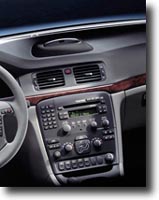 Comparatively, the S80 with T6 engine stacks up very well against the Mercedes 4.3 liter E Class, the Lexus LS 400 and BMW's 540IA. I checked the TACH Compar-a-graph (which can compare up to 4 cars head-to-head in more than 100 categories) and was very impressed. The S80 has as much or more interior room than any of the other vehicles (front & rear head, leg, shoulder & hip). The T6 engine delivers virtually the same horsepower as their V8s. I think the S80 looks as good as the other three (although, of course, it doesn't have the prestige of a Mercedes or BMW). And Volvo certainly has a safety and reliability record that's second to none. There's only one category in which I discovered the S80 fell short: price. The S80 with T6 engine; base priced at slightly more than $40,000; was about $10,000 to $13,000 less than the comparably powered competition. The 2.9 liter S80 is base priced at 35,820. Matching it up against such other 6 cylinder vehicles as Mercedes 3.2 liter E Class, BMW 528IA, and the Acura RL; it is $3,000 to $10,000 less.
Comparatively, the S80 with T6 engine stacks up very well against the Mercedes 4.3 liter E Class, the Lexus LS 400 and BMW's 540IA. I checked the TACH Compar-a-graph (which can compare up to 4 cars head-to-head in more than 100 categories) and was very impressed. The S80 has as much or more interior room than any of the other vehicles (front & rear head, leg, shoulder & hip). The T6 engine delivers virtually the same horsepower as their V8s. I think the S80 looks as good as the other three (although, of course, it doesn't have the prestige of a Mercedes or BMW). And Volvo certainly has a safety and reliability record that's second to none. There's only one category in which I discovered the S80 fell short: price. The S80 with T6 engine; base priced at slightly more than $40,000; was about $10,000 to $13,000 less than the comparably powered competition. The 2.9 liter S80 is base priced at 35,820. Matching it up against such other 6 cylinder vehicles as Mercedes 3.2 liter E Class, BMW 528IA, and the Acura RL; it is $3,000 to $10,000 less.
I never thought I'd say this about a car in the thirty and forty thousand-dollar range; but the S80 is priced too low!
And now, my secret discovery! Just as my guidebook suggested, because of the low population, driving in Sweden was a pleasure. Generally speaking, the drivers are polite and considerate, and the roads are in really good condition. However, the tailgating and passing will take your breath away, especially on two lane roads. When another vehicle wishes to pass, he or she will move up to within inches of your rear bumper. It is completely unnerving to the unsuspecting tourist. In fact, if it happened in Los Angeles or New York traffic, road-rage incidents would break out all over the place. On two lane roads, where you have one lane traveling in each direction, the passing vehicle will expect you to move as far to the right as possible, as he or she will pass you in the same lane. If there is insufficient room for you to move to the right, the passing vehicle will still pass by moving left, into on-coming traffic, expecting the on-coming vehicles to move to their right and let him or her through. I guess all the "expecting" works since in the roundtrip I made from Gothenburg to Stockholm (several hundred kilometers); I don't remember seeing any collisions. However, it made me think. With this high level of potential for serious accidents, the vehicles need significant protection. And as everyone knows, Swedish cars are famous for their safety. The only thing I couldn't figure out was the "chicken and the egg" question: are the vehicles built so safely because of how the people drive, or do the people drive the way they do because the cars are so safe?

